Nightingale's Environmental Theory and Nursing Practice Analysis
VerifiedAdded on 2023/05/30
|6
|1187
|382
Essay
AI Summary
This essay examines Nightingale's Environmental Theory, focusing on its application in nursing practice through a case study involving a 68-year-old patient with breast cancer, diabetes, and hypertension. The paper analyzes the five key components of the theory: clean water, fresh air, effective drainage, cleanliness, and light, and how they can be applied to improve the patient's recovery. It provides a detailed care plan prioritizing the management of the surgical site, addressing environmental factors, and managing the patient's chronic conditions. The essay also discusses the relevance of Nightingale's theory to the author's nursing practice, specifically in caring for cholera patients, emphasizing the importance of clean water and hygiene. The essay concludes by reinforcing the importance of environmental factors in patient recovery and their practical application in different nursing contexts.
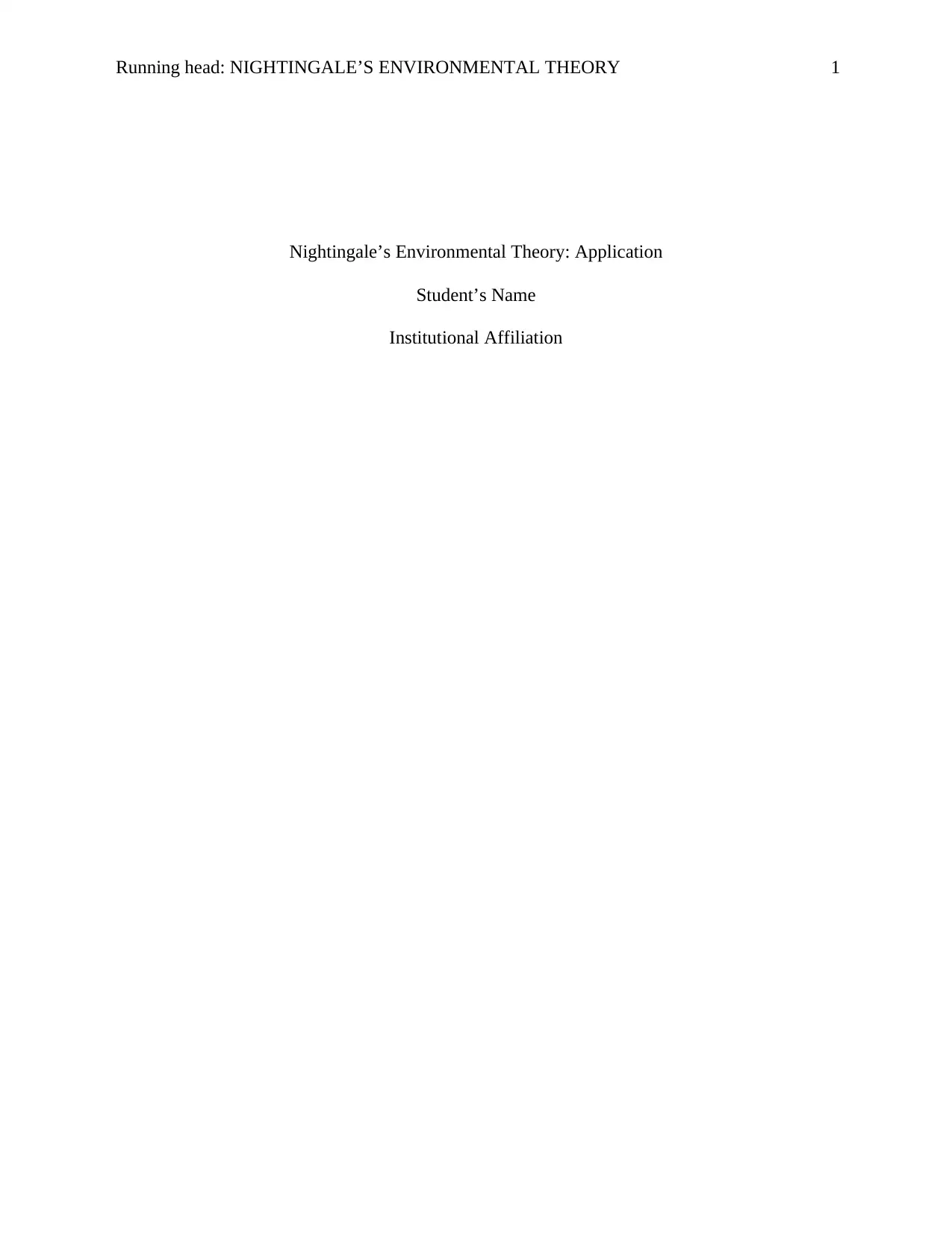
Running head: NIGHTINGALE’S ENVIRONMENTAL THEORY 1
Nightingale’s Environmental Theory: Application
Student’s Name
Institutional Affiliation
Nightingale’s Environmental Theory: Application
Student’s Name
Institutional Affiliation
Paraphrase This Document
Need a fresh take? Get an instant paraphrase of this document with our AI Paraphraser
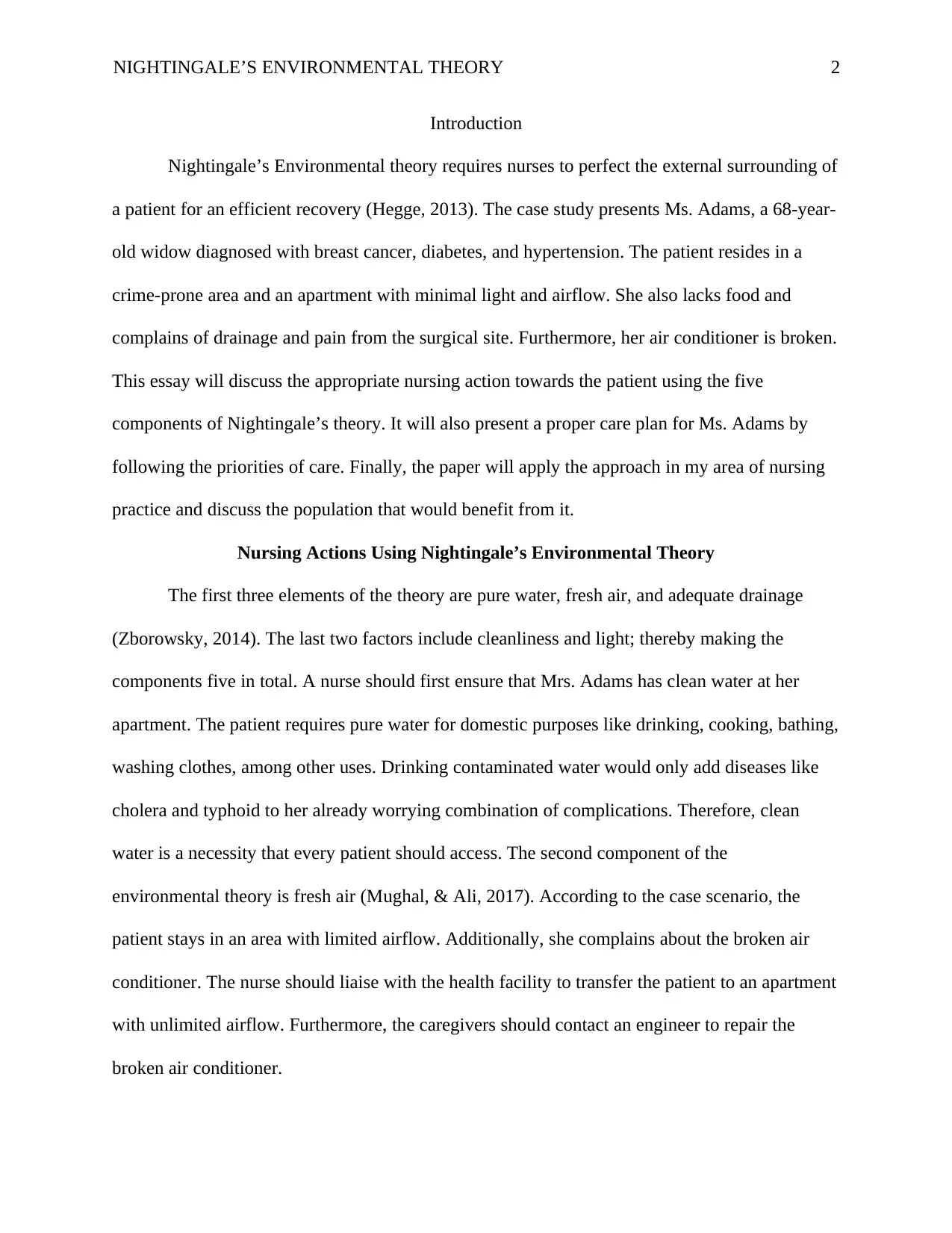
NIGHTINGALE’S ENVIRONMENTAL THEORY 2
Introduction
Nightingale’s Environmental theory requires nurses to perfect the external surrounding of
a patient for an efficient recovery (Hegge, 2013). The case study presents Ms. Adams, a 68-year-
old widow diagnosed with breast cancer, diabetes, and hypertension. The patient resides in a
crime-prone area and an apartment with minimal light and airflow. She also lacks food and
complains of drainage and pain from the surgical site. Furthermore, her air conditioner is broken.
This essay will discuss the appropriate nursing action towards the patient using the five
components of Nightingale’s theory. It will also present a proper care plan for Ms. Adams by
following the priorities of care. Finally, the paper will apply the approach in my area of nursing
practice and discuss the population that would benefit from it.
Nursing Actions Using Nightingale’s Environmental Theory
The first three elements of the theory are pure water, fresh air, and adequate drainage
(Zborowsky, 2014). The last two factors include cleanliness and light; thereby making the
components five in total. A nurse should first ensure that Mrs. Adams has clean water at her
apartment. The patient requires pure water for domestic purposes like drinking, cooking, bathing,
washing clothes, among other uses. Drinking contaminated water would only add diseases like
cholera and typhoid to her already worrying combination of complications. Therefore, clean
water is a necessity that every patient should access. The second component of the
environmental theory is fresh air (Mughal, & Ali, 2017). According to the case scenario, the
patient stays in an area with limited airflow. Additionally, she complains about the broken air
conditioner. The nurse should liaise with the health facility to transfer the patient to an apartment
with unlimited airflow. Furthermore, the caregivers should contact an engineer to repair the
broken air conditioner.
Introduction
Nightingale’s Environmental theory requires nurses to perfect the external surrounding of
a patient for an efficient recovery (Hegge, 2013). The case study presents Ms. Adams, a 68-year-
old widow diagnosed with breast cancer, diabetes, and hypertension. The patient resides in a
crime-prone area and an apartment with minimal light and airflow. She also lacks food and
complains of drainage and pain from the surgical site. Furthermore, her air conditioner is broken.
This essay will discuss the appropriate nursing action towards the patient using the five
components of Nightingale’s theory. It will also present a proper care plan for Ms. Adams by
following the priorities of care. Finally, the paper will apply the approach in my area of nursing
practice and discuss the population that would benefit from it.
Nursing Actions Using Nightingale’s Environmental Theory
The first three elements of the theory are pure water, fresh air, and adequate drainage
(Zborowsky, 2014). The last two factors include cleanliness and light; thereby making the
components five in total. A nurse should first ensure that Mrs. Adams has clean water at her
apartment. The patient requires pure water for domestic purposes like drinking, cooking, bathing,
washing clothes, among other uses. Drinking contaminated water would only add diseases like
cholera and typhoid to her already worrying combination of complications. Therefore, clean
water is a necessity that every patient should access. The second component of the
environmental theory is fresh air (Mughal, & Ali, 2017). According to the case scenario, the
patient stays in an area with limited airflow. Additionally, she complains about the broken air
conditioner. The nurse should liaise with the health facility to transfer the patient to an apartment
with unlimited airflow. Furthermore, the caregivers should contact an engineer to repair the
broken air conditioner.
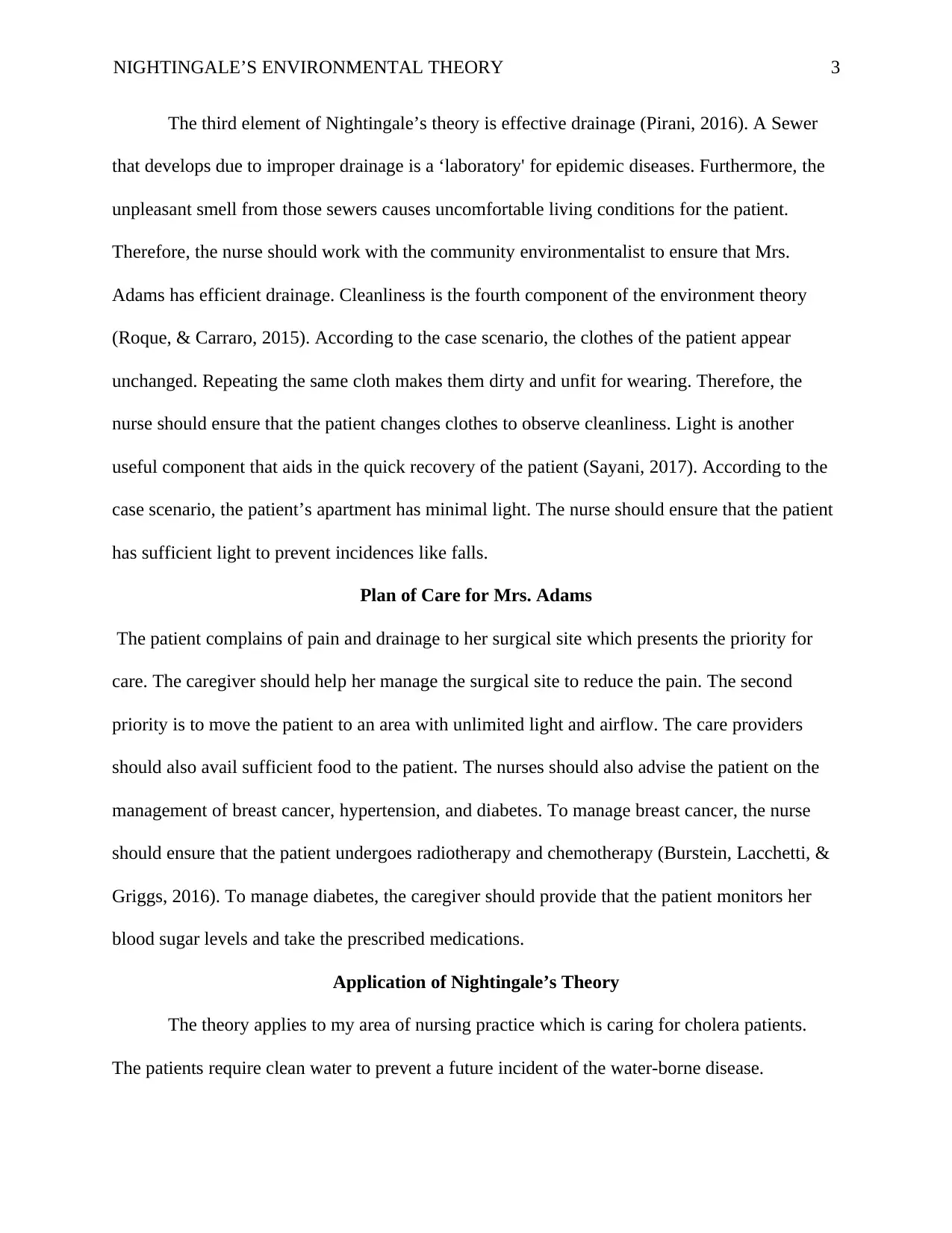
NIGHTINGALE’S ENVIRONMENTAL THEORY 3
The third element of Nightingale’s theory is effective drainage (Pirani, 2016). A Sewer
that develops due to improper drainage is a ‘laboratory' for epidemic diseases. Furthermore, the
unpleasant smell from those sewers causes uncomfortable living conditions for the patient.
Therefore, the nurse should work with the community environmentalist to ensure that Mrs.
Adams has efficient drainage. Cleanliness is the fourth component of the environment theory
(Roque, & Carraro, 2015). According to the case scenario, the clothes of the patient appear
unchanged. Repeating the same cloth makes them dirty and unfit for wearing. Therefore, the
nurse should ensure that the patient changes clothes to observe cleanliness. Light is another
useful component that aids in the quick recovery of the patient (Sayani, 2017). According to the
case scenario, the patient’s apartment has minimal light. The nurse should ensure that the patient
has sufficient light to prevent incidences like falls.
Plan of Care for Mrs. Adams
The patient complains of pain and drainage to her surgical site which presents the priority for
care. The caregiver should help her manage the surgical site to reduce the pain. The second
priority is to move the patient to an area with unlimited light and airflow. The care providers
should also avail sufficient food to the patient. The nurses should also advise the patient on the
management of breast cancer, hypertension, and diabetes. To manage breast cancer, the nurse
should ensure that the patient undergoes radiotherapy and chemotherapy (Burstein, Lacchetti, &
Griggs, 2016). To manage diabetes, the caregiver should provide that the patient monitors her
blood sugar levels and take the prescribed medications.
Application of Nightingale’s Theory
The theory applies to my area of nursing practice which is caring for cholera patients.
The patients require clean water to prevent a future incident of the water-borne disease.
The third element of Nightingale’s theory is effective drainage (Pirani, 2016). A Sewer
that develops due to improper drainage is a ‘laboratory' for epidemic diseases. Furthermore, the
unpleasant smell from those sewers causes uncomfortable living conditions for the patient.
Therefore, the nurse should work with the community environmentalist to ensure that Mrs.
Adams has efficient drainage. Cleanliness is the fourth component of the environment theory
(Roque, & Carraro, 2015). According to the case scenario, the clothes of the patient appear
unchanged. Repeating the same cloth makes them dirty and unfit for wearing. Therefore, the
nurse should ensure that the patient changes clothes to observe cleanliness. Light is another
useful component that aids in the quick recovery of the patient (Sayani, 2017). According to the
case scenario, the patient’s apartment has minimal light. The nurse should ensure that the patient
has sufficient light to prevent incidences like falls.
Plan of Care for Mrs. Adams
The patient complains of pain and drainage to her surgical site which presents the priority for
care. The caregiver should help her manage the surgical site to reduce the pain. The second
priority is to move the patient to an area with unlimited light and airflow. The care providers
should also avail sufficient food to the patient. The nurses should also advise the patient on the
management of breast cancer, hypertension, and diabetes. To manage breast cancer, the nurse
should ensure that the patient undergoes radiotherapy and chemotherapy (Burstein, Lacchetti, &
Griggs, 2016). To manage diabetes, the caregiver should provide that the patient monitors her
blood sugar levels and take the prescribed medications.
Application of Nightingale’s Theory
The theory applies to my area of nursing practice which is caring for cholera patients.
The patients require clean water to prevent a future incident of the water-borne disease.
⊘ This is a preview!⊘
Do you want full access?
Subscribe today to unlock all pages.

Trusted by 1+ million students worldwide
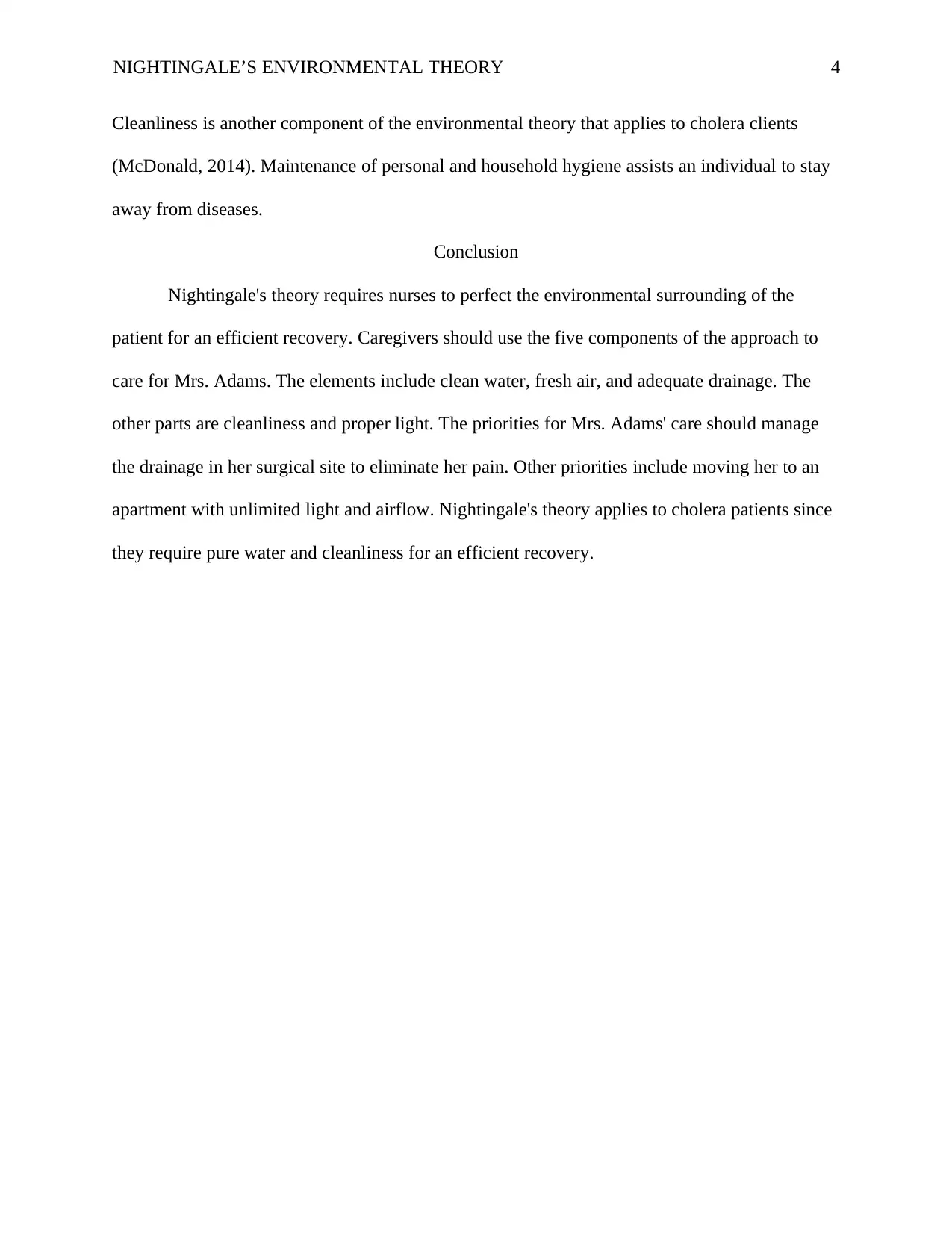
NIGHTINGALE’S ENVIRONMENTAL THEORY 4
Cleanliness is another component of the environmental theory that applies to cholera clients
(McDonald, 2014). Maintenance of personal and household hygiene assists an individual to stay
away from diseases.
Conclusion
Nightingale's theory requires nurses to perfect the environmental surrounding of the
patient for an efficient recovery. Caregivers should use the five components of the approach to
care for Mrs. Adams. The elements include clean water, fresh air, and adequate drainage. The
other parts are cleanliness and proper light. The priorities for Mrs. Adams' care should manage
the drainage in her surgical site to eliminate her pain. Other priorities include moving her to an
apartment with unlimited light and airflow. Nightingale's theory applies to cholera patients since
they require pure water and cleanliness for an efficient recovery.
Cleanliness is another component of the environmental theory that applies to cholera clients
(McDonald, 2014). Maintenance of personal and household hygiene assists an individual to stay
away from diseases.
Conclusion
Nightingale's theory requires nurses to perfect the environmental surrounding of the
patient for an efficient recovery. Caregivers should use the five components of the approach to
care for Mrs. Adams. The elements include clean water, fresh air, and adequate drainage. The
other parts are cleanliness and proper light. The priorities for Mrs. Adams' care should manage
the drainage in her surgical site to eliminate her pain. Other priorities include moving her to an
apartment with unlimited light and airflow. Nightingale's theory applies to cholera patients since
they require pure water and cleanliness for an efficient recovery.
Paraphrase This Document
Need a fresh take? Get an instant paraphrase of this document with our AI Paraphraser
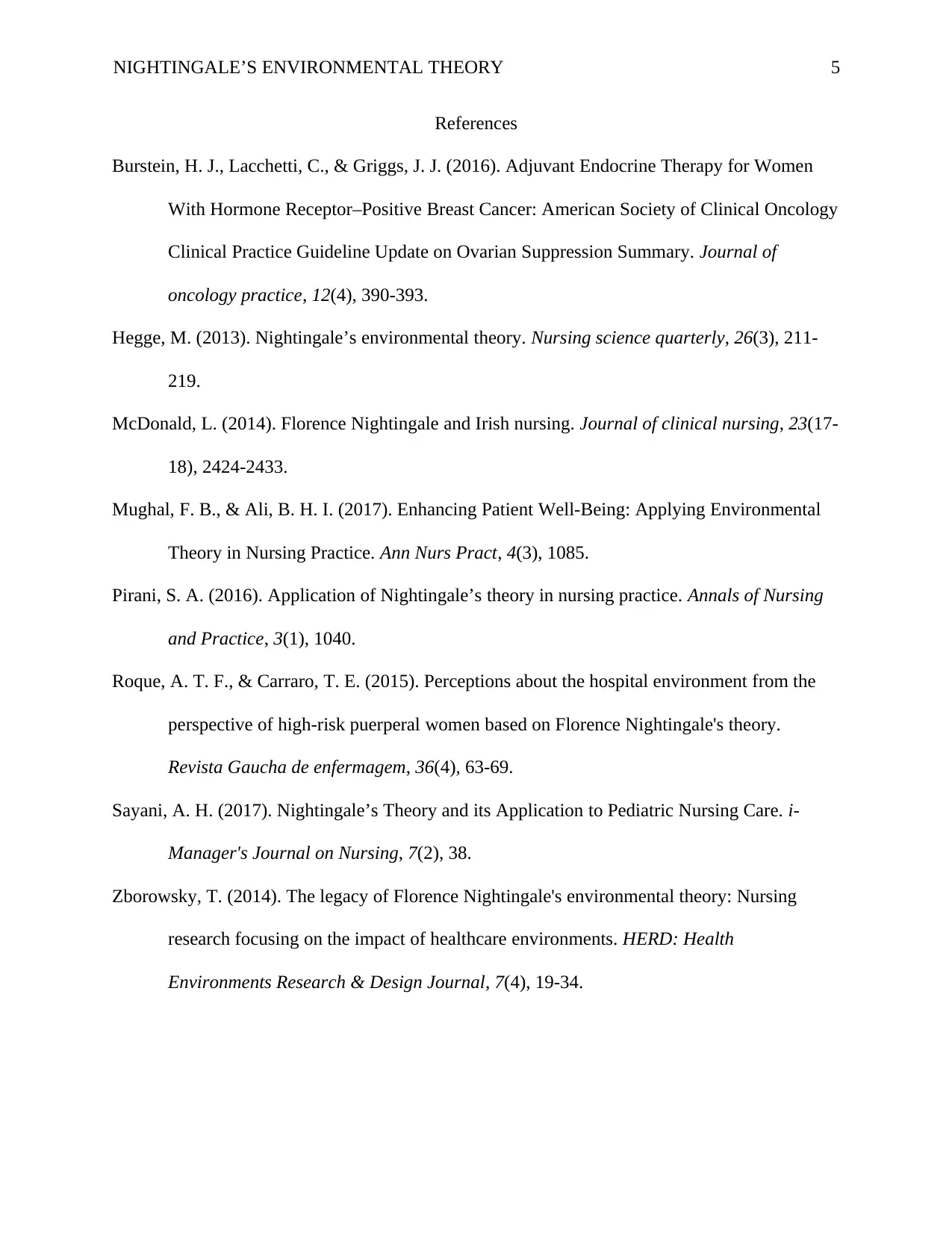
NIGHTINGALE’S ENVIRONMENTAL THEORY 5
References
Burstein, H. J., Lacchetti, C., & Griggs, J. J. (2016). Adjuvant Endocrine Therapy for Women
With Hormone Receptor–Positive Breast Cancer: American Society of Clinical Oncology
Clinical Practice Guideline Update on Ovarian Suppression Summary. Journal of
oncology practice, 12(4), 390-393.
Hegge, M. (2013). Nightingale’s environmental theory. Nursing science quarterly, 26(3), 211-
219.
McDonald, L. (2014). Florence Nightingale and Irish nursing. Journal of clinical nursing, 23(17-
18), 2424-2433.
Mughal, F. B., & Ali, B. H. I. (2017). Enhancing Patient Well-Being: Applying Environmental
Theory in Nursing Practice. Ann Nurs Pract, 4(3), 1085.
Pirani, S. A. (2016). Application of Nightingale’s theory in nursing practice. Annals of Nursing
and Practice, 3(1), 1040.
Roque, A. T. F., & Carraro, T. E. (2015). Perceptions about the hospital environment from the
perspective of high-risk puerperal women based on Florence Nightingale's theory.
Revista Gaucha de enfermagem, 36(4), 63-69.
Sayani, A. H. (2017). Nightingale’s Theory and its Application to Pediatric Nursing Care. i-
Manager's Journal on Nursing, 7(2), 38.
Zborowsky, T. (2014). The legacy of Florence Nightingale's environmental theory: Nursing
research focusing on the impact of healthcare environments. HERD: Health
Environments Research & Design Journal, 7(4), 19-34.
References
Burstein, H. J., Lacchetti, C., & Griggs, J. J. (2016). Adjuvant Endocrine Therapy for Women
With Hormone Receptor–Positive Breast Cancer: American Society of Clinical Oncology
Clinical Practice Guideline Update on Ovarian Suppression Summary. Journal of
oncology practice, 12(4), 390-393.
Hegge, M. (2013). Nightingale’s environmental theory. Nursing science quarterly, 26(3), 211-
219.
McDonald, L. (2014). Florence Nightingale and Irish nursing. Journal of clinical nursing, 23(17-
18), 2424-2433.
Mughal, F. B., & Ali, B. H. I. (2017). Enhancing Patient Well-Being: Applying Environmental
Theory in Nursing Practice. Ann Nurs Pract, 4(3), 1085.
Pirani, S. A. (2016). Application of Nightingale’s theory in nursing practice. Annals of Nursing
and Practice, 3(1), 1040.
Roque, A. T. F., & Carraro, T. E. (2015). Perceptions about the hospital environment from the
perspective of high-risk puerperal women based on Florence Nightingale's theory.
Revista Gaucha de enfermagem, 36(4), 63-69.
Sayani, A. H. (2017). Nightingale’s Theory and its Application to Pediatric Nursing Care. i-
Manager's Journal on Nursing, 7(2), 38.
Zborowsky, T. (2014). The legacy of Florence Nightingale's environmental theory: Nursing
research focusing on the impact of healthcare environments. HERD: Health
Environments Research & Design Journal, 7(4), 19-34.

NIGHTINGALE’S ENVIRONMENTAL THEORY 6
⊘ This is a preview!⊘
Do you want full access?
Subscribe today to unlock all pages.

Trusted by 1+ million students worldwide
1 out of 6
Your All-in-One AI-Powered Toolkit for Academic Success.
+13062052269
info@desklib.com
Available 24*7 on WhatsApp / Email
![[object Object]](/_next/static/media/star-bottom.7253800d.svg)
Unlock your academic potential
Copyright © 2020–2025 A2Z Services. All Rights Reserved. Developed and managed by ZUCOL.

